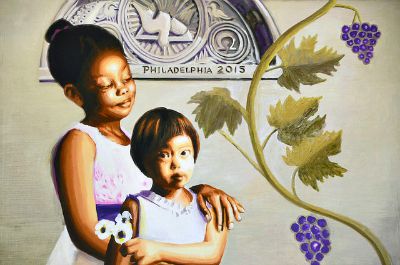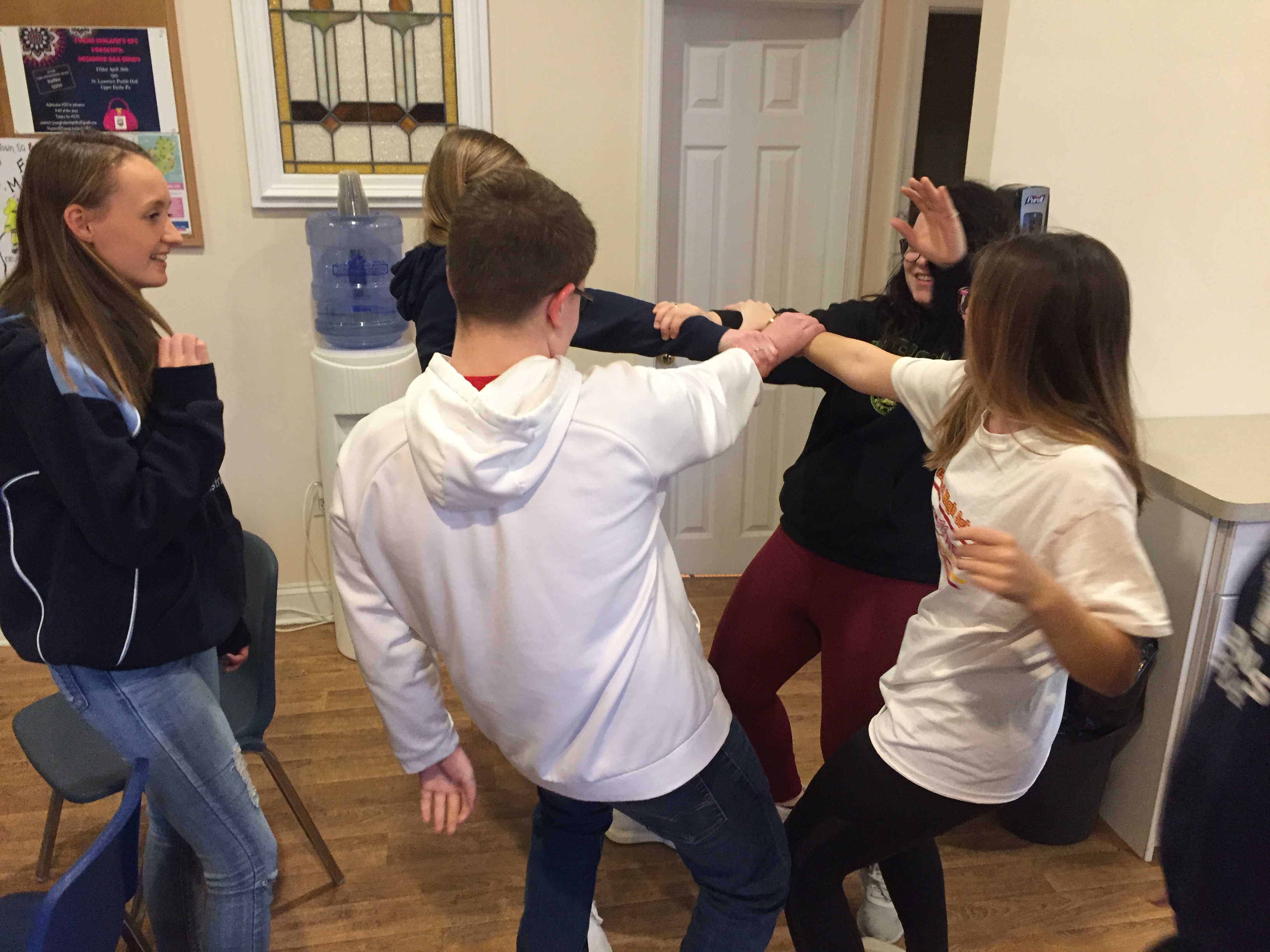Margie Riccheza, a fine arts student at Temple’s Tyler School of Art, is sitting cross-legged on the floor in a wide open studio on Vine Street, carefully applying a ribbon of dark pink paint onto a five-foot-square sheet of parachute cloth. Thin lines of ink delineate the area where she applies the paint, and that particular area is marked with a number corresponding to the color of paint she is to use in that space.
The whole sheet is like that—streaks and squiggles and amoeba-shaped spots bounded by thin lines, each space marked with a roughly drawn number. This is paint-by-the-numbers on a huge scale. Many brightly colored panels line the wall. Some are completed, and others—like this one—are works in progress.
At a table nearby, Monica Matthieu sits, snipping small bits of colored glass into rough-edged shapes, gluing them onto large flower-shaped forms. “It’s like a puzzle, but with color,” she says, smiling, but not looking up from her work. “It’s very relaxing.”
It might not look like much yet, but come November, 153 of those panels—along with little decorative touches like Matthieu’s delicate cut glass flowers—will blend together against the brick wall of the new St. Malachy School in North Philly to form a 4,239-square-foot mural commemorating Pope Francis’s visit to Philadelphia.
The World Meeting of Families and the City of Philadelphia Mural Arts Program commissioned the oversized work of art. Wells Fargo is sponsoring the project.
Looking at all of those giant puzzle pieces that somehow have to come together to form a kind of seamless whole against the side of a big building, you might expect mural artist Cesar Viveros to be a bundle of nerves. If he is, he doesn’t show it.
Sitting on a folding chair in his studio and looking relaxed and informal in a neat black t-shirt, scuffed topsiders and well-worn jeans, with black shoulder-length hair and neatly trimmed goatee, he explains: He has done this kind of thing before. Big art is nothing new to him.
It started when Viveros arrived in Philadelphia in 1997. He already had a background in art—a kind of accidental background, which started in his days working as an industrial diver on oilrigs in the Gulf of Mexico, where an off-time hobby as a painter resulted in a series of commissions. “When bad weather happens (on a rig),” Viveros says, “there’s not too much to do. I just started painting.” He smiles when he remembers one of his clients, a man in Kentucky who asked him to paint a portrait of his favorite horse. “I figured, why not?”
In some ways, Viveros says, he grew up surrounded by big art. In Mexico, mural art dates back to the years before the Spanish conquest. Mexico City in particular is renowned for its murals—including those of the great Diego Rivera and the revolutionary (and not just in an artistic sense) David Alfaro Siqueiros. Viveros claims both as early influences. “In Mexico City,” he says, “you will see all kinds of murals on public buildings. It’s monumental work, but it’s more accessible.”
Somewhere along the line, Viveros’ artistic appetites grew. Portraits were nice, but he longed for a grander canvas.
“I came to Philly looking for the opportunity to be in some kind of program,” Viveros says. “I decided to come to a city where someone knows something. I guess I was lucky because the Mural Arts Program has been here since 1984. That’s how I came to Philadelphia.”
One day, still new in town, Viveros came across a huge mural in progress at Broad and Spring Garden—Meg Saligman’s “Common Threads”. Scaffolding draped the wall of the building.
“I approached the person who was doing the mural, and asked if I could help. She said, yeah, come up the scaffolding. I volunteered with her, “ Viveros recalls. It didn’t take long before he was hooked, and his own natural talent came to the fore. “I always say that I went up the scaffolding as a visitor and came down as an apprentice.”
After that, Viveros went back to Mexico, but he later returned to Philadelphia and became a legal resident. He rejoined Saligman on a particularly poignant project—a September 11th commemorative American flag mural that adorned the side of a warehouse at Christopher Columbus Boulevard and Spring Garden Street.
Viveros was a quick learner. “When we finished that,” he says, “I was asked to do my own designs and work independently.”
Viveros has created a good deal of mural art since then. You can now find his work in many neighborhoods throughout the city. “My Life, My Path, My Destiny” at Aramingo Avenue and E. Lehigh Avenue is one of many shining examples. But of all his work, the St. Malachy mural is particularly meaningful. The papal visit, he notes, “is the biggest event in the city in this decade.”
After the World Meeting of Families granted Viveros his commission, he cruised the city, looking for a suitable building, taking photos. When he saw the side of the new St. Malachy School, he knew he’d found his canvas. With two projecting walls on either side and a recessed wall in the middle, it gave Viveros the opportunity to create an enormous triptych.
 St. Malachy’s is a historically Irish parish, founded in 1850, which evolved over the years to reflect the diverse population of its surrounding community. Its highly acclaimed school is now governed by the nonprofit Independence Mission Schools and in a new building, the former William Harrison School at 1012 W. Thompson Street.
St. Malachy’s is a historically Irish parish, founded in 1850, which evolved over the years to reflect the diverse population of its surrounding community. Its highly acclaimed school is now governed by the nonprofit Independence Mission Schools and in a new building, the former William Harrison School at 1012 W. Thompson Street.
Viveros asked St. Malachy officials for permission to use the building, and permission was happily granted. Then, he set to work, planning to execute a project that up to that point had existed only as a much smaller rendering that he had presented to officials at the World Meeting of Families.
The mural is expected to reflect religious themes, of course, with appropriate images—chalice, baptismal font, lamb, dove. Just as importantly, the mural is intended to portray the sanctity and unity of the family. So there are depictions of a boy praying, a girl presenting three delicate flowers to a younger girl with Down Syndrome, a couple with a baby, and—notably—Pope Francis, smiling, with his hand on the shoulder of a boy. They look like they’re having a friendly little chat.
All of the images reflect the racial diversity of the city, and they’re based on photographs Viveros took of real people. “The image of the boy praying is from the elementary school where my kids go,” Viveros says.
Work on the panels has been ongoing, with “paint days” sponsored throughout the city at institutions as diverse as Divine Providence Village Day Services Program in Delaware County, Little Sisters of the Poor Holy Family Home in West Philadelphia, Father Judge High School, Children’s Hospital of Philadelphia … and of course, St. Malachy. More than 2,000 volunteers have taken part. Attendees at the World Meeting of Families will also try their hand.
By the time of the convention—which coincides with the pope’s visit at the end of September, the two projecting walls will be completed. The recessed center wall is reserved for those attending the World Meeting of Families.
Viveros holds out hope that one very special artist will take his brush in hand to complete the work.
“Hopefully the pope will make the last brush stroke,” says Viveros. “If he paints one stroke, that for me would be like Jesus taking holy water and applying it to the wall.”
[flickr_set id=”72157656901462632″]


